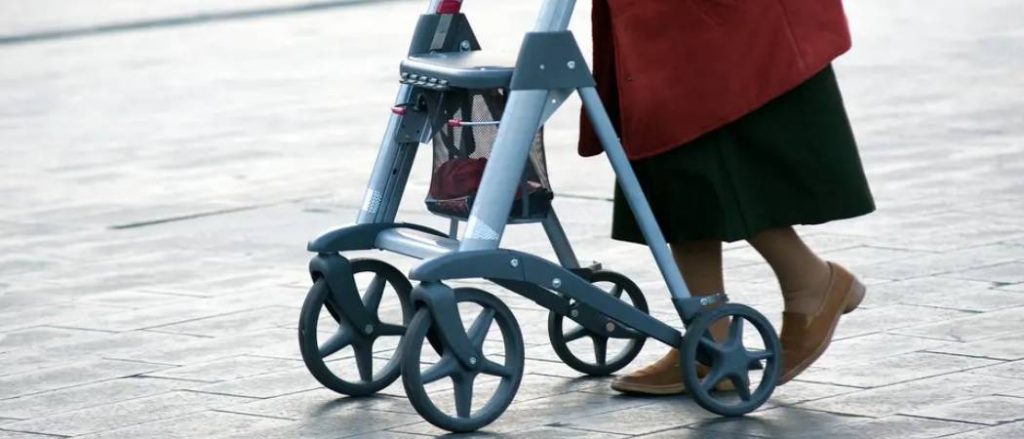The freedom to move about is essential to maintaining an active, involved, and connected lifestyle.
However, even the simplest activities, like walking or getting around, may be highly challenging and discouraging for those with difficulty walking.
Rollators may be necessary for a renewed sense of independence in such cases.
The article will go into the world of rollators, discussing their characteristics, advantages, and how they may significantly enhance the lives of individuals in need.
What is a Rollator?
A rollator, often called a mobility or wheeled walker, is a helpful mobility aid that makes it easier for those with trouble walking or keeping their balance on their own two feet.
A rollator is a creative mobility aid that can help those recovering from an injury, dealing with a chronic disease, or needing a little more help getting around.
Even older adults with dependency or restricted mobility benefit immensely from their use.
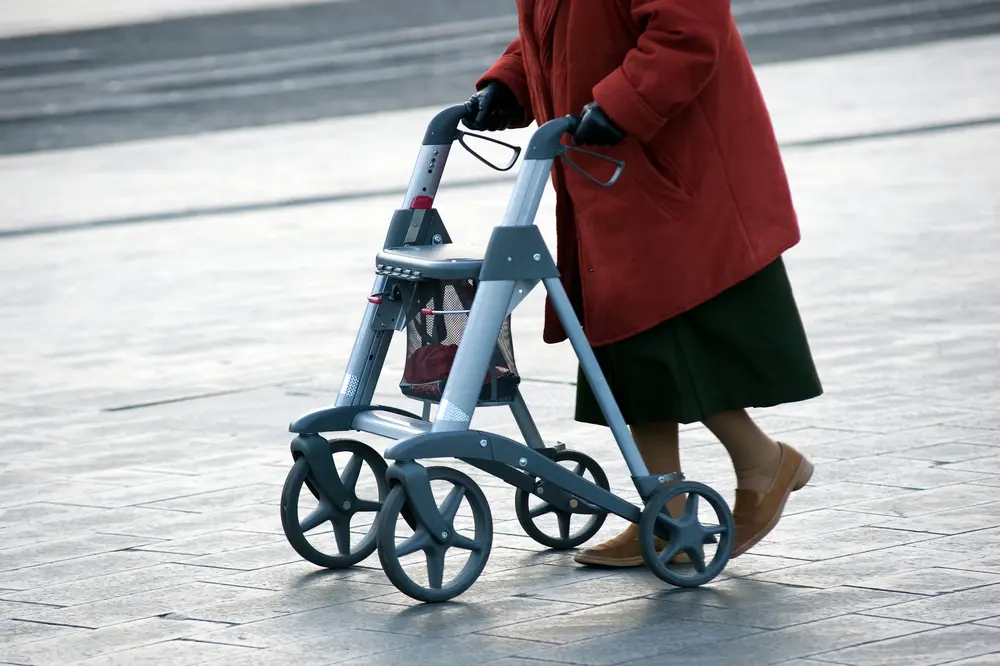
Components of a Rollator
Rollator has a built-in seat fixed to its robust frame, four wheels, and grabbing handlebars. It gives walkers something solid to depend on, which helps them keep their balance and prevent tripping. The details of the components of the rollator are given below.
Frame: The frame is what gives the rollator its shape and stability. It is often constructed from lightweight materials like aluminum for convenience and portability.
Handlebars: The rollator is easily maneuvered thanks to the ergonomically designed handlebars. Typically, they can be adjusted to suit a range of user heights.
Seat: A built-in seat is a convenient addition to many rollators, allowing users to sit comfortably and rest whenever needed. In most cases, the seat is cushioned for comfort.
Wheels: Rollators have four wheels, making them stable and straightforward to control. The Wheels can be either solid or pneumatic.
These wheels allow easy navigation on uneven terrain or short distances, while the seat gives a comfortable resting spot when tiredness sets in.
Brakes: The brakes on a rollator can keep the equipment from rolling away or keep the user stable when seated.
Storage: As an added convenience, many rollators feature storage baskets or bags to hold the user’s personal items, shopping bags, or medical supplies.
In the short video above, Lindsay, an occupational therapist, explains the rollator’s details and uses, as mentioned earlier.
Types of Rollators
One can choose from a variety of rollators tailored for specific situations:
Four Wheel-Rollators
4-wheeled rollators, also known as 4-wheel rollator walkers, are a popular type of mobility aid that offers enhanced support, stability, and versatility. These rollators feature a four-wheel configuration, with two larger wheels at the front and two smaller wheels at the back.
The ProBasics Transport Rollator comes in the four-wheel category with all the features. Learn more about them in our dedicated article about four-wheeled devices here.
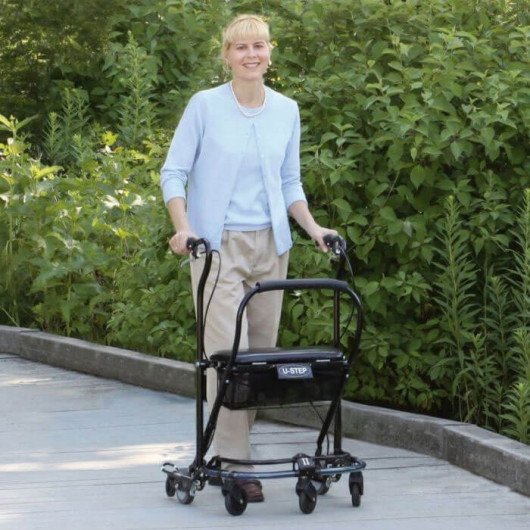
Three-Wheel Rollator
Rollators with three wheels are more compact and slender than those with four-wheel rollators. The standard features include brakes and handlebars for security and stability. Three-wheel rollators are usually perfect for indoor use and small settings.
Lightweight Rollator
Lightweight rollators are folding rollators that are more portable and easier to move. They are perfect for people with difficulties with mobility or who rely on transportation often.
The best in this category is the Drive Clever Lite Walker Rollator, which has a paddle mechanism, flip-up seat, carrying handle, and backrest that folds up for travel or storage.
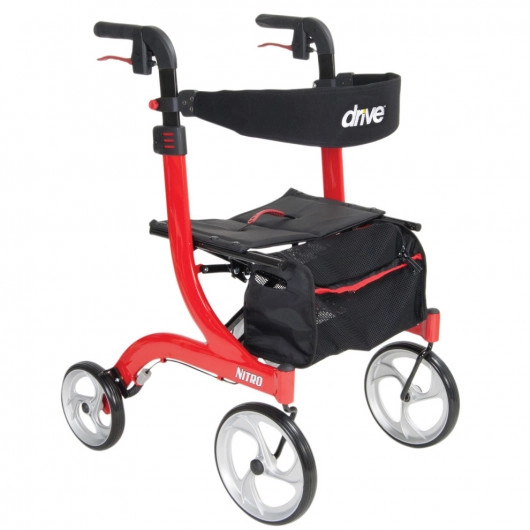
Bariatric Rollator
Bariatric rollators are sturdy walkers with increased weight capabilities. They’re tailored to fit those with a larger body weight and frame.
Our Karman Extra Wide Bariatric Rollator is the best example of a bariatric rollator with a bodyweight capacity of up to 400 lbs. and sturdy support, including a flip-down padded seat.
Combined Rollator/Transport Chair
The hybrid rolling walkers are very new to the market and combine a four-wheeled rollator with the basic wheelchair functionality of a transport chair.
The height-adjustable seat is present, but the handles are moved behind the user so that they can be pushed. Adjustable or detachable footrests are utilized to increase comfort.
These two-in-one devices have safer frames than standard walkers, making them more convenient for transport. Our Rollz Motion 2 Rollator & Transport Chair in One is the perfect choice for these rollators.
What is The Difference Between a Rolling Walker and a Rollator?
Walkers and rollators may appear to be identical at first. Many people refer to rollators as wheeled walkers.
Despite their apparent similarities, a walker and a rollator have specific benefits and drawbacks that should be considered when making your final selection.
The differences are mentioned below,
- A rollator has four wheels, handlebars, and other features like seat and storage options, whereas a rolling walker has four legs or two legs and two wheels at the front and a more basic design.
- When compared to rollators, rolling walkers need lifting and coordinating with each step, but rollators may be pushed along with ease without weight bearing.
- For people who have trouble keeping their balance, a rolling walker is a wonderful choice with wheel-less stable support, while those who can do so can benefit from a rollator’s enhanced mobility and adaptability.
- Unlike rollators, which are intended for indoor and outdoor use on various surfaces, rolling walkers are generally used indoors on flat surfaces or for short distances.
- Rolling walkers are usually not equipped with accessories, whereas rollators have specific space for rollator accessories.
Here is a quick recap in a video about the main difference between rolling walkers and rollators.
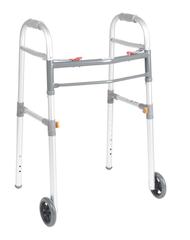
Benefits of Using a Rollator
A rollator may improve mobility and quality of life for those recovering from an injury, living with a chronic disease, or requiring assistance with walking and as much stability as they require.
Let’s discuss some of the most significant benefits of using a rollator.
Enhanced Mobility
Rollators help users feel more confident and stable while navigating their surroundings. It can improve one’s mobility and connection to the outside world by allowing them to travel, take strolls, shop, and participate in community events, allowing individuals to move farther without fatigue.
Independence
Rollators let people get around without continual help, allowing them to regain their independence, and an elevated sense of autonomy makes for a more exciting and satisfying way of living.
According to a recent study published in 2023, adults over 75 favored using a rollator for walking and autonomy.
Safety
Rollators are safety devices with reliable brakes and stable frames, reducing fall risk for individuals with balance issues or limited strength. They offer peace of mind, providing extra support and protection for users and their loved ones.
A recent study conducted in 2023 found that patients with Parkinson’s disease who used rollators effectively decreased falls.
Improved Endurance
Individuals can progressively increase their walking speed and distance by using a rollator to improve their physical endurance.
Storage Basket
Rollators offer convenient storage options and accessories like baskets and pouches for transporting belongings, food, or medical supplies, eliminating the need for extra bags or goods.
Users of mobility aids such as rollators indicated high satisfaction levels and regular usage, as evidenced by the interview and data analysis.
What Is the Disadvantage of a Rollator?
Although there are numerous benefits to using a rollator, and they are a popular and helpful mobility aid, there are also some disadvantages to consider.
Risk of Unintended Movement
Rollators have wheels on all four legs, so leaning on them might be risky. Even with the hand brakes, the walker can roll out from under you if you put too much weight on it.
Limited Maneuverability in Tight Spaces.
Because of its oversized design and larger wheels, a rollator can be challenging to maneuver through small entrances, packed hallways, and other tight spaces.
Going through these areas without harm may require more time, energy, or support.
Less Compatible than Other Mobility Aids
Rollators may not be as easily transportable as other mobility aids. Many rollators may be folded for transportation and storage, but they still take up space, which may be inconvenient for frequent travelers or those with limited space.
Dependency on Upper Body Strength
Utilizing a rollator may demand considerable upper-body strength and coordination. The inability to grip or push may make it difficult for those with inadequate upper body strength or other medical issues to utilize a rollator efficiently.
Other kinds of mobility aids or help might be preferable in such cases.
Weight and Size Considerations
Some rollators are heavy and challenging, which can be problematic for those with limited strength or mobility. That is why The size and weight of a rollator are two considerations that the buyer should make.
Who Should Not Use a Rollator Walker?
Picking a rollator that is both comfortable and safe to use is a top priority. Many people find rollators helpful. However, there are situations in which their use might not be the best option, including the following.
- Severe weakness or limited mobility, like stroke and sarcopenia, may cause a struggle with rollator walker usage due to upper body strength and coordination. Alternative mobility aids may be preferable.
- Rollator walkers may not be appropriate for those with significant cognitive impairments, such as advanced dementia or severe confusion.
- Rollators may not be suitable for individuals with severe arthritis, joint deformities, post-operative limitations, or injuries, as they may require alternative mobility aids or adjustments for safety.
- People with extreme balancing issues are not good candidates for rollators. In such cases, different mobility aids, such as walking frames or walking sticks, may be advised.
- If someone cannot bear weight on their legs or requires constant assistance, a wheelchair or other full-support mobility aid may be more suitable.
Consider the demands and consult a medical specialist to decide if a rollator walker is right for you.
Real-Life Examples Of People Using Rollators as Mobility Aid
Michael J. Fox, a prominent actor now living with Parkinson’s disease, has spoken candidly about his life with the condition and his experience using a rollator. The rollator has allowed him to maintain public appearances and campaigns, encouraging others and bringing attention to Parkinson’s disease.
Another well-known example is Muhammad Ali, the great boxer and cultural icon, who used a rollator for mobility. Ali, who had Parkinson’s disease, relied on a rollator to go around. He continued his humanitarian work and public appearances, inspiring many despite his health problems.
Perlette Rigsby, a 60-year-old adult, shared his review on a forum about using rollators instead of standard walkers. When he fractured his pelvis bone, his physical therapist prescribed a rollator for indoor use, and he found it easy to maneuver. The rollator has a sufficient seat height and basket for carrying groceries and can be used outdoors.
Dagmar Munn shares her journey using rollators. She was diagnosed with ALS at 50 and prescribed a rollator for everyday tasks. She didn’t like it but slowly adjusted to it. She uses it as an emergency landing pad at the bathroom sink, a daily exercise routine, and a silent companion.
Munn admits that after living with a rollator for six years, she cannot imagine her life without one, and she now owns three rollators. She adds that it has undoubtedly become a constant companion, providing security and comfort during various activities.
Conclusion
Using a rollator is a great way to maintain an active and involved lifestyle and regain independence.
Individuals with restricted mobility can benefit significantly from rollators because they provide support, stability, and freedom. They may be found in various forms and provide advantages such as greater mobility, freedom, security, and a higher quality of life.
Individuals can experience the benefits of this versatile device by selecting a suitable rollator and adhering to proper maintenance and safety guidelines. Contacting a doctor or mobility expert about your options is an excellent idea to improve your mobility and quality of life.
